Showing Spotlights 129 - 136 of 624 in category All (newest first):
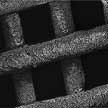 MXenes are a promising class of 2D materials with unique intrinsic physical and chemical properties, including excellent conductivity, hydrophilicity and high density when compared to graphene. 3D-printed architectures composed of MXenes are particularly attractive for energy storage applications such as rechargeable lithium- and sodium-ion batteries, lithium-sulfur batteries and supercapacitors. Researchers now have demonstrated for the first time the possibility to print three-dimensional freestanding MXene objects.
MXenes are a promising class of 2D materials with unique intrinsic physical and chemical properties, including excellent conductivity, hydrophilicity and high density when compared to graphene. 3D-printed architectures composed of MXenes are particularly attractive for energy storage applications such as rechargeable lithium- and sodium-ion batteries, lithium-sulfur batteries and supercapacitors. Researchers now have demonstrated for the first time the possibility to print three-dimensional freestanding MXene objects.
Aug 6th, 2019
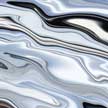 The recent interest of nanotechnology researchers in liquid metals is based on the properties that differentiate them from common liquids such as water or organics. In addition to their chemical reactivity, the electronic behavior of these liquids, combined with the strong interatomic interactions throughout the bulk, lead to liquids with high densities, thermal and electrical conductivities, and optical reflectivity (over a wide range of wavelengths). This offers potential new approaches for the synthesis of nanomaterials and investigations of fundamental physics and chemistry at small length scales.
The recent interest of nanotechnology researchers in liquid metals is based on the properties that differentiate them from common liquids such as water or organics. In addition to their chemical reactivity, the electronic behavior of these liquids, combined with the strong interatomic interactions throughout the bulk, lead to liquids with high densities, thermal and electrical conductivities, and optical reflectivity (over a wide range of wavelengths). This offers potential new approaches for the synthesis of nanomaterials and investigations of fundamental physics and chemistry at small length scales.
Jul 11th, 2019
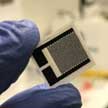 Bagasse is a waste plant matter obtained by food industry processes with major potential for several high-value products. An innovative idea of utilizing bagasse is for production of nanocellulose and testing this for wound dressing devices, manufactured by 3D printing. The next step in the development of wound dressings is the personalized aspect of the biomaterials, i.e. wound dressings that are structured and composed of constituents specially selected for a specific wound and wound treatment. Furthermore, sensors could be integrated into wound dressings and thus monitor various aspects of wound development, e.g. moisture and exudates in chronic wounds.
Bagasse is a waste plant matter obtained by food industry processes with major potential for several high-value products. An innovative idea of utilizing bagasse is for production of nanocellulose and testing this for wound dressing devices, manufactured by 3D printing. The next step in the development of wound dressings is the personalized aspect of the biomaterials, i.e. wound dressings that are structured and composed of constituents specially selected for a specific wound and wound treatment. Furthermore, sensors could be integrated into wound dressings and thus monitor various aspects of wound development, e.g. moisture and exudates in chronic wounds.
Jun 3rd, 2019
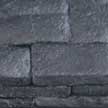 Highly compressible graphene aerogels possess extraordinary properties that exceed the performance of natural materials - superior compressive elasticity; ultrahigh porosity; outstanding tolerance for harsh environment; large specific surface area; high electrical and thermal conductivity. Now, researchers have fabricated graphene aerogel 'bricks' that can be assembled into much larger aerogel structures. These highly oriented and dense microstructures possesses arbitrary macroscale, outstanding compressive strength, superelasticity, and high conductivity.
Highly compressible graphene aerogels possess extraordinary properties that exceed the performance of natural materials - superior compressive elasticity; ultrahigh porosity; outstanding tolerance for harsh environment; large specific surface area; high electrical and thermal conductivity. Now, researchers have fabricated graphene aerogel 'bricks' that can be assembled into much larger aerogel structures. These highly oriented and dense microstructures possesses arbitrary macroscale, outstanding compressive strength, superelasticity, and high conductivity.
May 6th, 2019
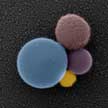 Inspired by chiral molecular structures, scientists are developing strategies to build artificial chiral materials by mimicking natural molecular structures using functional materials. Specifically, metal nanomaterials exhibit tailorable optical properties upon excitation of surface plasmons and become one of the most promising components to realize chiral optical metamaterials. New work provides a macroscopic model to understand the origin of chirality because the structures of the chiral meta-molecules are observable under a microscope and also the optical chirality is several orders of magnitude stronger than the intrinsic chirality of organic molecules.
Inspired by chiral molecular structures, scientists are developing strategies to build artificial chiral materials by mimicking natural molecular structures using functional materials. Specifically, metal nanomaterials exhibit tailorable optical properties upon excitation of surface plasmons and become one of the most promising components to realize chiral optical metamaterials. New work provides a macroscopic model to understand the origin of chirality because the structures of the chiral meta-molecules are observable under a microscope and also the optical chirality is several orders of magnitude stronger than the intrinsic chirality of organic molecules.
Mar 14th, 2019
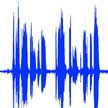 Researchers report a simple, innovative and inexpensive design of a vitamin-based hybrid biocompatible nanogenerator with energy harvesting ability from various energy sources in a single device. This is the first time that inexpensive and biocompatible vitamin B2 has been used as a novel and effective beta-phase stabilizer to enhance the piezoelectric performance of PVDF. The attractiveness of using vitamin B2 is that it is biodegradable and biocompatible, thermodynamically stable, low-cost, has delocalized pi-electrons, contains multiple numbers of hydroxyl groups, carbonyl groups and amino groups in its backbone.
Researchers report a simple, innovative and inexpensive design of a vitamin-based hybrid biocompatible nanogenerator with energy harvesting ability from various energy sources in a single device. This is the first time that inexpensive and biocompatible vitamin B2 has been used as a novel and effective beta-phase stabilizer to enhance the piezoelectric performance of PVDF. The attractiveness of using vitamin B2 is that it is biodegradable and biocompatible, thermodynamically stable, low-cost, has delocalized pi-electrons, contains multiple numbers of hydroxyl groups, carbonyl groups and amino groups in its backbone.
Feb 28th, 2019
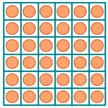 DNA nanotechnology employs DNA as a programmable building material for self-assembled, nanoscale structures with precisely controlled structures, that can lead to improved surface properties relevant to biosensing, materials science, and cell biology. Adding to the available tools for DNA nanopatterning, researchers have demonstrated a novel biotemplating strategy for ordering various nanoparticles into expected two-dimensional (2D) patterns via nanoparticle-surface or nanoparticle-DNA interaction.
DNA nanotechnology employs DNA as a programmable building material for self-assembled, nanoscale structures with precisely controlled structures, that can lead to improved surface properties relevant to biosensing, materials science, and cell biology. Adding to the available tools for DNA nanopatterning, researchers have demonstrated a novel biotemplating strategy for ordering various nanoparticles into expected two-dimensional (2D) patterns via nanoparticle-surface or nanoparticle-DNA interaction.
Feb 27th, 2019
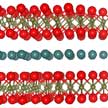 Potassium niobate (KNbO3) is a a perovskite ferroelectric crystal that, due to its optical properties, has been found useful in many different areas of materials science research, including electro-optics, piezoelectric, and electronic applications. Researchers have now, for the first time, succeeded in producing large KNbO3 crystals with uniform flat shape, and c-axis texture, which makes the crystals useful for practical electro-optic applications. By using MXenes as precursor materials to grow ferroelectric crystals, their 2D nature is inherited by the ferroelectric crystals.
Potassium niobate (KNbO3) is a a perovskite ferroelectric crystal that, due to its optical properties, has been found useful in many different areas of materials science research, including electro-optics, piezoelectric, and electronic applications. Researchers have now, for the first time, succeeded in producing large KNbO3 crystals with uniform flat shape, and c-axis texture, which makes the crystals useful for practical electro-optic applications. By using MXenes as precursor materials to grow ferroelectric crystals, their 2D nature is inherited by the ferroelectric crystals.
Feb 25th, 2019
 MXenes are a promising class of 2D materials with unique intrinsic physical and chemical properties, including excellent conductivity, hydrophilicity and high density when compared to graphene. 3D-printed architectures composed of MXenes are particularly attractive for energy storage applications such as rechargeable lithium- and sodium-ion batteries, lithium-sulfur batteries and supercapacitors. Researchers now have demonstrated for the first time the possibility to print three-dimensional freestanding MXene objects.
MXenes are a promising class of 2D materials with unique intrinsic physical and chemical properties, including excellent conductivity, hydrophilicity and high density when compared to graphene. 3D-printed architectures composed of MXenes are particularly attractive for energy storage applications such as rechargeable lithium- and sodium-ion batteries, lithium-sulfur batteries and supercapacitors. Researchers now have demonstrated for the first time the possibility to print three-dimensional freestanding MXene objects.
 Subscribe to our Nanotechnology Spotlight feed
Subscribe to our Nanotechnology Spotlight feed





